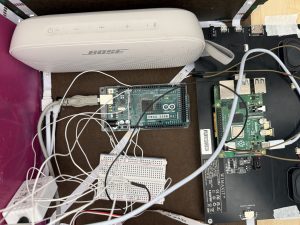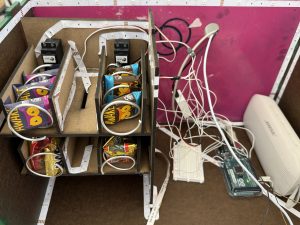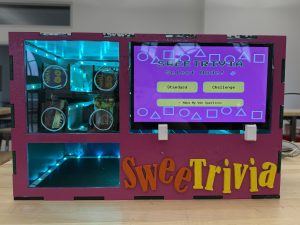This week:
- Hardware Fabrication & Setup
I spent significant time laser cutting and assembling key components of our vending machine. I laser cut structural parts and began researching how to enable kiosk mode on the Raspberry Pi, alongside digging into the persistent issues with text-to-speech narration. The following day, I laser cut the main board for the project and spent the evening at TechSpark, taking advantage of tools and space to focus on precision fabrication. I also laser cut the SweeTrivia letters and front panel, and glued the candy dispensing wire into place on the motor using hot glue to keep things neat and secure.
- Audio Output & Narration Integration
After struggling to resolve the TTS issue using other tools, I successfully connected the Raspberry Pi’s audio output to an external speaker. However, the audio narration works on my local laptop, not in the rpi, so I am planning to move back to espeak-ng from the browser-based web API. I restored narration using espeak-ng, which offered much more reliable performance. This works on my local, so I will have to test this out on Sunday(3/30) if this works with the rpi as well.
- Candy Selection Logic & User Feedback
I focused on refining the candy selection interface and ensuring it functioned properly with the point system. Previously, the screen displayed incorrect options, especially when the user reached 50 points, and the game automatically ended. I fixed the logic so that no matter how many points the user gets, it shows the exit/continue option only if 10 seconds have passed. Additionally, I implemented a candy dispense eligibility logic so that users are only able to select candies that are priced within the user’s budget. Affordable candies are shown, and added new feedback mechanisms: if the user has zero points, they’re redirected to the home screen once they decide to exit since there is no need for candy dispension, and if they try to purchase something they can’t afford, a warning saying “Not enough points!” appears instead of failing silently. These enhancements improve both usability and gameplay clarity
<Video of standard code gameplay: 3.29 Standard Mode Gameplay>
I think I am on schedule, but I will have to keep testing the audio using the external speakers and changing back to espeak-ng.
In the upcoming week(3/30-4/5), I am planning to continue developing both the functionality and user experience of the vending machine system by accomplishing the following:
- test the Raspberry Pi audio narration using espeak-ng to ensure consistent and clear voice output across different stages of the game.
- prepare for our in-class demo by ensuring the core features—including candy selection, narration, and screen transitions—are working smoothly together.
Since narration is a key component of user engagement and accessibility, I want to verify that the system behaves reliably during full gameplay runs, including transitions between questions and responses to user input.
After the demo on April 2nd, I plan to implement a more sophisticated points-based shopping system. Instead of a one-at-a-time candy selection, this upgrade will allow users to select multiple candies as long as their total selections of candies stay within their point budget. This feature will more closely resemble real-world shopping behavior and enhance gameplay flexibility.
Following that, I also intend to finalize the UI/UX elements and refine them based on peer feedback and demo observations. Improvements may include clearer visual cues, responsive buttons, and improved text readability. Additionally, I am also looking into randomizing the trivia questions each time the game is played to improve replayability and make the experience more dynamic for users who return to the machine more than once.




